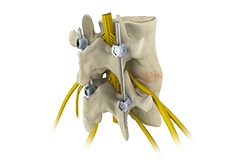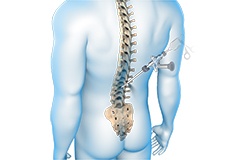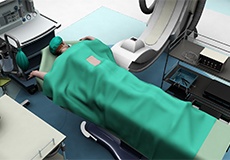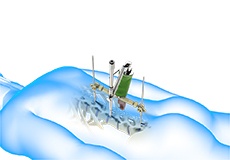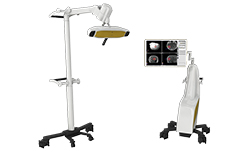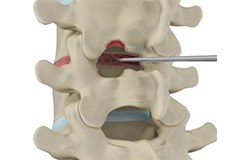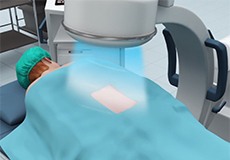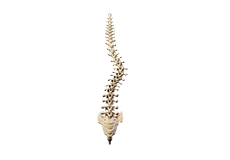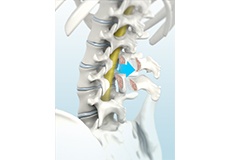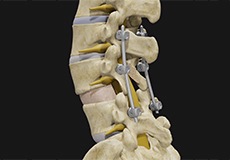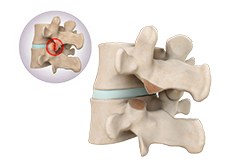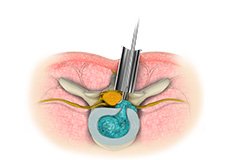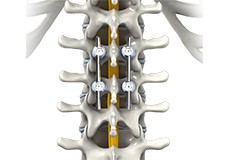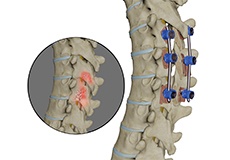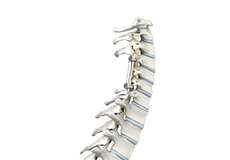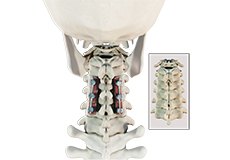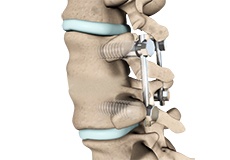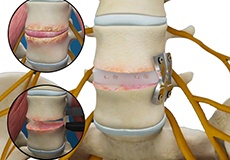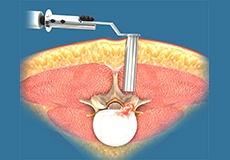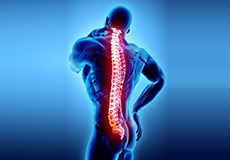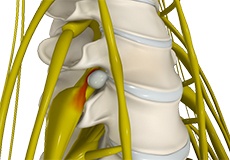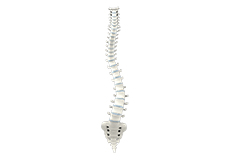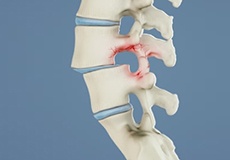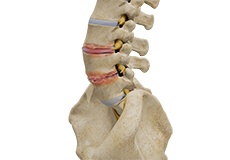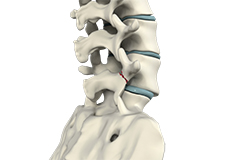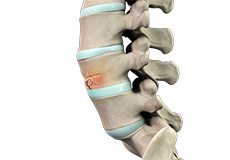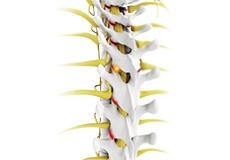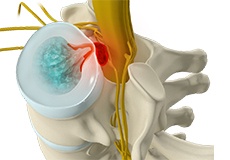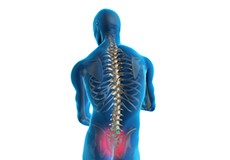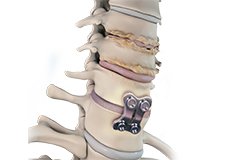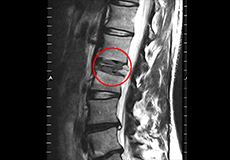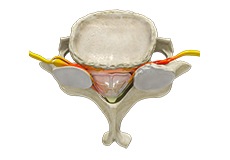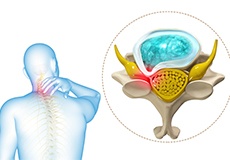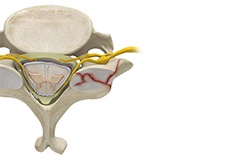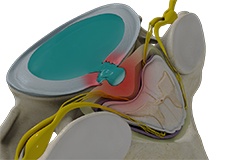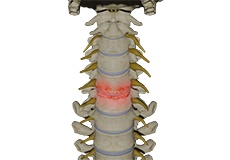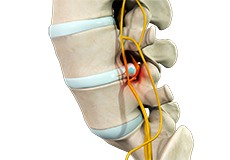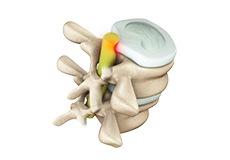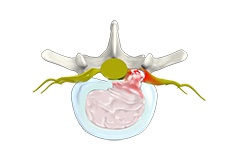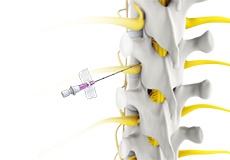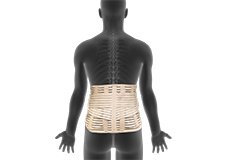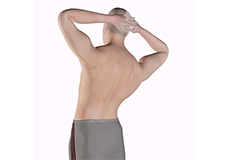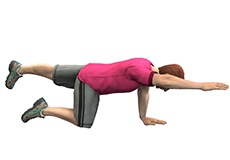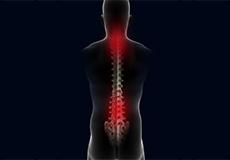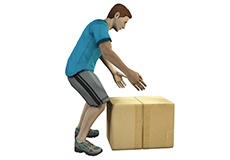-
Non-Surgical Spine Treatments
In most cases, back pain can be resolved without surgery. The conservative treatment involves the use of pain medications and other methods to reduce inflammation and restore normal function.
-
Minimally Invasive Spine Surgery
Minimally invasive spine surgery (MISS) is the latest technology available to perform spinal surgeries through small, less than one-inch-long incisions.
-
Spinal Fusion
Spinal fusion is the surgical technique of combining two or more vertebrae. A fusion of the vertebrae involves the insertion of secondary bone tissue obtained either from an autograft (tissues from your own body) or allograft (tissues from another person) to enhance the bone healing process.
-
Endoscopic Spine Surgery
Endoscopic spine surgery is a minimally invasive spine surgery that uses specialized video cameras and instruments to remove the herniated disc through very small incisions.
-
Revision Spinal Surgery
Robotic spine surgery is a procedure where your surgeon is assisted by a robotic system to perform surgery to the spine. Precision is very important when performing spine surgery.
-
Robotic Spine Surgery
Computer-assisted spine surgery is an instrument tracking technology in which the surgical instruments are viewed with the help of three-dimensional images of the spine.
-
Computer-Assisted Spine Surgery
Computer-assisted spine surgery is an instrument tracking technology in which the surgical instruments are viewed with the help of three-dimensional images of the spine.
-
Complex Spinal Reconstruction
Complex spinal reconstruction is a major surgical procedure to correct spine deformities and associated symptoms such as pain, numbness, and instability in your back, shoulders, arms, or legs.
-
Artificial Cervical Disc Replacement
Artificial cervical disc replacement is a spine surgery to replace a degenerated (deteriorated) disc in the neck with an artificial disc. The artificial disc, like the natural healthy disc, is used to replace the degenerated disc.
-
Kyphoplasty
Balloon kyphoplasty is a spine surgery that relieves back pain caused by a vertebral compression fracture. The aim of balloon kyphoplasty is to relieve pain, stabilize the fracture and restore the vertebral body height.
-
Spinal Decompression
Spinal decompression is a treatment to relieve pressure on one or many “pinched nerves” in the spinal column. It can be achieved either surgically or by non-surgical methods.
-
Image-Guided Spine Surgery
Imaging techniques such as computed tomography and fluoroscopy may be integrated into the system to facilitate pre-operative planning of the surgery, where a series of images taken before the surgery are displayed on a screen, with which your surgeon matches his/her moves intraoperatively.
-
Adult Scoliosis Correction
Adult scoliosis is the abnormal curvature of the spine giving the spine an “S” or “C” shape in a skeletally mature person. Larger curves cause discomfort while smaller curves usually do not cause any problems.
-
Laminectomy
Laminectomy refers to the removal or cutting of the lamina (roof) of the vertebral bones to provide space for the nerves to exit from the spine. It can also be performed to relieve the symptoms of the narrowed spinal canal known as spinal stenosis.
-
Spondylolisthesis Reduction & Fusion
Spondylolisthesis is a condition characterized by the displacement of one vertebra over the other. Excessive displacement may compress the surrounding spinal nerves and cause pain.
-
Lateral Extracavitary Approach Surgery
Many approaches have been introduced in spinal surgery to gain optimal access to the injured or diseased area, with minimal or no damage to surrounding tissues. There are three main approaches – anterior (from the front), posterior (from the back) and lateral (from the side).
-
Removal of Facet Joint Cyst
Facet joint cysts, also called synovial cysts, are benign, fluid-filled sacs that develop due to degeneration of the facet joints of the spine. These cysts normally occur in the lumbar spine (lower back) area and may not cause problems, but when large enough, they can cause spinal stenosis or narrowing of the spinal canal leading to compression of the spinal cord or spinal nerves.
-
Microscopic Spine Surgery
Microscopic spine surgery is a minimally invasive surgical procedure performed using state-of-the-art technology to treat conditions pertaining to the spine.
-
Spine Surgery in Athletes
Spine surgery is an operative procedure performed to correct spinal abnormalities. Athletes can undergo sports injuries to the spine requiring spine surgery. A sports injury is a physical trauma sustained by a direct impact, overuse, or application of greater force than the body can withstand during a sports activity.
-
Fracture Stabilization
A spinal fracture refers to a break in any of the bones that make up the spine. It can occur due to trauma such as a traffic accident, fall from a significant height or weakening of the bones due to osteoporosis or a tumor.
-
Cervical Arthroplasty
Arthroplasty is a surgical procedure to restore joint function by replacing a damaged joint with an artificial joint called a prosthesis.
-
Cervical Spine Fusion
Cervical spine fusion is a surgery performed to fuse weak cervical vertebrae with adjacent vertebrae to provide stability and prevent injury to the spinal cord.
-
Posterior Cervical Fusion
Posterior cervical fusion (PCF), a surgical procedure performed through the back of the neck, involves joining or fusing two or more damaged cervical vertebrae. The fusion of vertebrae is also known as arthrodesis. Sometimes, metallic plates may be used for fixing the vertebrae, this is also known as instrumentation.
-
Cervical Laminoplasty
A cervical laminoplasty is an operative procedure that involves reshaping/repositioning the bone at the neck region (cervical spine) to relieve excess pressure on the spinal nerves. It can also be performed to relieve the symptoms of the narrowed spinal canal known as spinal stenosis.
-
Lumbar Fusion
Spinal fusion, also called arthrodesis, is a surgical technique used to join two or more vertebrae (bones) within the spine. Lumbar fusion is the procedure of fusing the vertebrae in the lumbar portion of the spine (lower back).
-
Lateral Lumbar Interbody Fusion
The back is made up of a number of small bones called vertebrae. Cushioning discs present between the vertebrae act as shock absorbers. The vertebral column allows the cylindrical bundle of nerve fibers called the spinal cord to pass through the entire column length and branch out to the various parts of the body.
-
Minimally Invasive Lumbar Surgery
A minimally invasive technique is more beneficial for a few lumbar surgeries. Some of the common minimally invasive lumbar surgical procedures include lumbar discectomy, lumbar fusion, and lumbar laminectomy.
-
Understanding Your Neck and Back Pain
The neck supports and assists in movement of the head. It is the most flexible part of the spine and consists of 7 cervical vertebrae, the cervical segment of the spinal cord, spinal nerves, ligaments, tendons, and muscles.
-
Disc Herniation
Disc herniation is a condition where the central nucleus pushes through the outer edge of the disc, causing a bulge that compresses the spinal nerves.
-
Adult Degenerative Scoliosis
Adult degenerative scoliosis is characterized by side to side or lateral bending of the spine in adults. Degenerative scoliosis can involve either the mid-back and/or lower back region of the spine.
-
Spondylolisthesis
Spondylolisthesis is the displacement of the vertebral disc from the spinal column. Outward (forward) displacement is termed as anterolisthesis and inward (backward) displacement is termed as retrolisthesis.
-
Degenerative Disc Disease
Degenerative disc disease (DDD) refers to the gradual deterioration of the intervertebral discs between the vertebrae. DDD is a misnomer as it is not actually a disease but a condition that affects the strength, resilience
-
Spine Trauma
Spine trauma is defined as an injury or damage to any region of the spine. The spine extends from the neck to the lower back and consists of the vertebral bones which surround and protect the spinal cord.
-
Spinal Infection
A spinal infection is described as an infection of the spine. It can occur in various locations of the spine i.e., intervertebral disc space, vertebral column, spinal canal, and nearby soft tissues.
-
Spinal Instability
Spinal instability refers to the condition of failure of the spinal column to maintain its normal structure. Normally, the spine functions to protect and provide support to the body and its internal organs.
-
Spondylolysis
Spondylolysis is a stress fracture in the vertebra that may progress into spondylolisthesis, a condition where the vertebra gets displaced from the spinal column. Spondylolysis is the cause of frequent low back pain in children.
-
Spinal Stenosis
Spinal stenosis is a condition caused by the vertebral column constricting and exerting pressure on the spinal cord or neural foramen (a bony tunnel through which a nerve exits the spinal cord).
-
Vertebral Compression Fractures
Back pain is an indication of stress fractures known as vertebral compression fractures. Vertebral compression fractures occur when the normal vertebral body of the spine is squeezed or compressed.
-
Facet Joint Arthritis
Facet joints, also called zygapophyseal joints, are synovial joints located at the back of your spine, connecting the vertebrae together. Normally the facet joints are lined by a cartilage and a membrane of synovium.
-
Cauda Equina Syndrome
What Cauda equina syndrome is an emergency condition characterized by persistent severe lower back pain caused by the compression of a bundle of spinal nerves (cauda equina) at the end of the spinal cord (lower back and hip region).
-
Sacroiliac Joint Dysfunction
Sacroiliac joint dysfunction or sacroiliac joint pain is one of the common causes of low back pain.
-
Adjacent Segment Disc Disease
Spinal fusion surgery involves the fusion of two or more vertebral bones and is a standard of care for spinal deformities and conditions such as radiculopathy, myelopathy, and spondylolisthesis.
-
Pathological Fractures of the Spine
Pathological fractures are broken bones in an area already weakened by another disease, not by an injury. Some underlying diseases can weaken the bones making them brittle and eventually causing a fracture or break in the bone.
-
Epidural Abscess
An epidural abscess is a medical condition that can be defined as an infection in the region between the spine, or bones of the skull, and the membranes that surround the spinal cord (meninges) and brain.
-
Osteoporosis of the Spine
Osteoporosis is a bone disease characterized by a decrease in bone mass and density resulting in brittle, fragile bones that are more susceptible to fractures.
-
Cervical Stenosis
Cervical stenosis refers to the narrowing of the spinal canal that protects the spinal cord and its branching nerves.
-
Cervical Radiculopathy/Myelopathy
Disc protrusion, also called herniated disc, is a condition caused by a tear in an intervertebral disc, allowing the disc contents to bulge out.
-
Cervical Spondylosis
Cervical spondylosis, also called arthritis of the neck, is an age-related medical condition characterized by deterioration of spinal joints, vertebrae, discs, and ligaments in your neck.
-
Cervical Fracture
Cervical fractures are common in motor vehicle accidents, sports activities and falls. The second, sixth and seventh cervical vertebrae are frequently involved in fractures, which may injure the spinal cord.
-
Cervical Disc Herniation
Cervical disc herniation can arise due to aberrations of the intervertebral disc such as bulging, rupture, and slipped or extruded disc. It results in neck, shoulder, and arm pain.
-
Cervical Degenerative Disc Disease
Cervical degenerative disc disease (DDD) is a misnomer, as it is not a disease as such but a condition that affects the strength, resiliency and structural integrity of the intervertebral discs due to increasing age, trauma, injury, repetitive movement, improper posture, or poor body mechanics.
-
Lumbar Stenosis
Lumbar stenosis is the compression of spinal nerves caused by the narrowing of the spinal canal. It is one of the common causes of lower back pain. Spinal stenosis can also affect the spine in the neck region.
-
Lumbar Radiculopathy
Back pain is a common condition affecting approximately 80% of the population at some point in their lives. The area usually affected is the lower back (lumbar region) as it bears most of the upper body’s weight.
-
Lumbar Disc Herniation
Lumbar disc herniation is the most common cause of lower back pain and leg pain (sciatica). Aging, injury or trauma may cause the annulus fibrosus to tear, resulting in protrusion of the nucleus pulposus.
-
Non-Operative Treatments for Lower Back Injuries
Non-operative treatments for lower back injuries are conservative or non-surgical remedies employed for the treatment of lower back injuries.
-
Back and Neck Braces
The spine is composed of spinal bones called vertebrae, intervertebral discs, connective tissue, and muscles. All of these structures provide support, stability, and mobility to the upper body. The spine also protects the delicate spinal cord.
-
Back Pain Exercises
Strenuous activities of daily living can stress the back resulting in pain. It is natural at this time to withdraw from activity and rest, but is not helpful in the long run and may actually slow down the healing process.
-
Nutrition and Your Spine
Nutrients are the chemical components present in food, which provide energy for carrying out normal physiological functions and aid in various metabolic processes of the body.
-
Spine Rehabilitation
Your rehabilitation team consists of physical therapists, orthopedic doctors, massage therapists and athletic trainers (in case of rehabilitation for sports injuries). The rehabilitation team works on various physical activities and flexibility exercises that help to regain the strength and motion of the injured site.
-
Healthy Back Tips
Back and neck pain is the most common health problems experienced by most people, at some point in their lives. People with back pain or neck pain may have trouble performing daily routine activities.
-
Proper Lifting
Lifting heavy weights and improper lifting of weights is one of the foremost causes of neck pain or lower back pain. Practicing proper lifting techniques is essential to avoid strain on your neck and back.
-
Am I a Candidate for Spine Surgery?
Spinal issues manifest in a large number of people at all phases of life. Back pain is one of the most common complaints that individuals visit a doctor for. Many orthopedic issues such as arthritis and other joint problems are manifested in the spine.
Introduction
The spine, also called the backbone, is made up of vertebral bones with cushioning intervertebral discs between them. The spine is designed to give us stability and smooth movement, as well as providing a corridor of protection for the delicate spinal cord. It is supported by muscles, tendons and ligaments, and innervated by nerves that branch out from the centrally placed spinal cord.
Having a well-functioning healthy back is essential for our mobility and ability to participate in various activities. Understanding the anatomy of the spine enhances your ability to discuss conditions of the spine and treatment options with your doctor.
Vertebra
The spine is made up of bony segments called vertebrae, and fibrous tissue called intervertebral discs. The vertebrae and discs form a column from your head to your pelvis providing symmetry and movement to the body.
This spinal column is made up of approximately 33 vertebral bones stacked one on top of the other from the base of the skull to the pelvis. Twenty four of these vertebrae articulate with each other, while the last nine are fused together. Each vertebra is made up of several parts:
Vertebral body
This is the main part of the vertebra. It supports most of the load while standing and provides a platform for the attachment of the intervertebral discs.
Pedicles
These are two cylinder-shaped projections originating from the back of the vertebral body, connecting the front and back of the vertebra.
Lamina
Lamina are a pair of flat arched bones that form the roof of the spinal canal and provide support and protection to the spinal cord at the back.
Spinous processes
These are the bony projections that arise at right angles to the midline of the lamina. These projections can be felt when touching the back.
Transverse processes
These are bony protrusions located at the junction of the pedicle and lamina. They provide a place for the attachment of the back muscles.
Spinal canal
This is the tunnel formed at the center of the vertebra for the passage of the spinal cord.
Facet joints
These are paired articular processes found at the vertebral arch. Each vertebra consists of two pair of facet joints: one pair called superior facets articulates with the vertebra above and the other pair, inferior facets articulates to the vertebra below.
Intervertebral discs
The intervertebral discs are flat, rounded soft tissue structures situated between two vertebral bodies of the spine.
The discs are composed of a tough, fibrous outer ring called the annulus fibrous and a soft, inner core called the nucleus pulposus. Intervertebral discs function as shock absorbers for the spine.
Aging and injury can cause degeneration of these discs and cause painful rubbing of the vertebral bones.
Vertebral column
The vertebrae are arranged one on top of the other to form the spine. The spine is categorized into 5 spinal segments: cervical, thoracic, lumbar, sacral and coccyx.
Cervical
The cervical spine is called the neck. It begins at the base of the skull and is comprised of seven vertebrae numbered C1 to C7. The neck supports the weight of the head and allows the greatest range of motion due to two specially shaped vertebrae, the ring-shaped atlas and the peg-shaped axis, which are the first two vertebrae.
Thoracic
The thoracic spine is made up of twelve thoracic vertebrae, which are numbered T1 to T12. They start from the upper chest and extend to the middle back, communicating with the ribs in the front of the chest to protect the heart and lungs.
Lumbar
The Lumbar spine is made up of five lumbar vertebras numbered L1 to L5. These are situated in the lower back region and are larger in size. The major function of the lumbar vertebrae is to carry the weight of the body and absorb the stress of lifting and carrying heavy objects.
Sacrum
The sacrum is a single bone, formed by the fusion of five sacral vertebras together. It connects the spine to the hip bones.
Coccyx
Also called the tailbone, the coccyx is formed from the fusion of four bones and provides attachment for muscles and ligaments to the pelvic floor.
Spinal curves
The side view of an adult spine resembles a natural S-shaped curve. The curves provide strength and support to the spine, maintain balance and absorb shock. Any abnormality in the spinal alignment is called a spinal deformity.
Muscles
The most important spinal muscles include the extensors, flexors and oblique muscles, which work to stabilize the spine and allow the spine to move.
The extensor muscles are attached to the back of the spine and help us to stand and lift objects.
The flexor muscles originate from the front of the spine and include the muscles of the abdomen. These help in forward movement and lifting and controlling the arch of the lower back.
The oblique muscles are found at the sides of the body and help in the side-ways rotation of the back.
Any weakness or strain in the back muscles can cause incredible strain on the spine.
Ligaments
Spinal ligaments are strong fibrous bands that stabilize and hold the vertebrae in place. The major ligaments are the ligamentum flavum, anterior longitudinal ligament, and posterior longitudinal ligament. The anterior and posterior longitudinal ligaments are continuous bands that run from the top to the bottom of the spinal column along the vertebral bodies, and the ligamentum flavum attach one lamina to the other.
These ligaments function to maintain the alignment of the vertebrae.
Spinal cord
The spinal cord originates from the brain and extends through the base of the skull to the lower back through the spinal canal. It is covered by three membranes called meninges. Spaces between these membranes are filled with cerebrospinal fluid.
There are 31 pairs of spinal nerves that originate from the spinal cord. These nerves carry all the information from the body to the brain, controlling sensation and movement.
Any damage or injury to the spinal cord can cause loss of sensation or function to the part of the body that the nerves supply.
Conclusion
The spine is a complex anatomical structure made up of bones, joints, tendons, ligaments, muscles, nerves, and the spinal cord. This strong spinal column provides the basic structure, support and flexibility to the human body.




